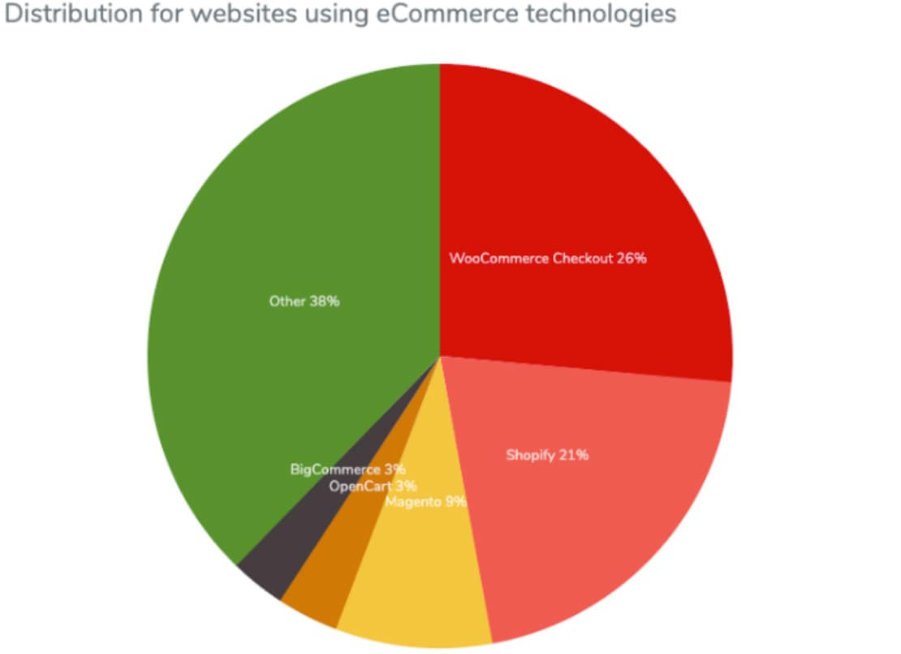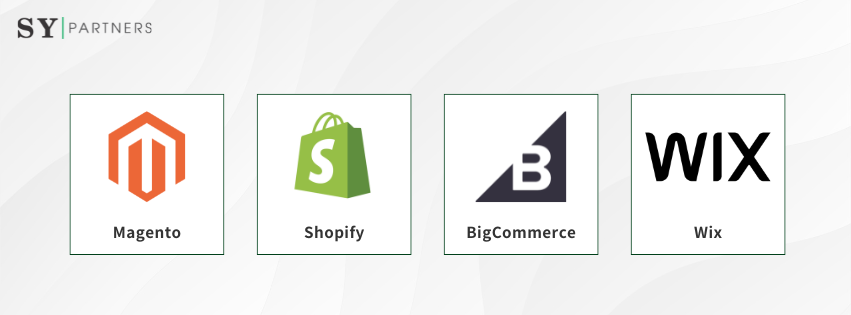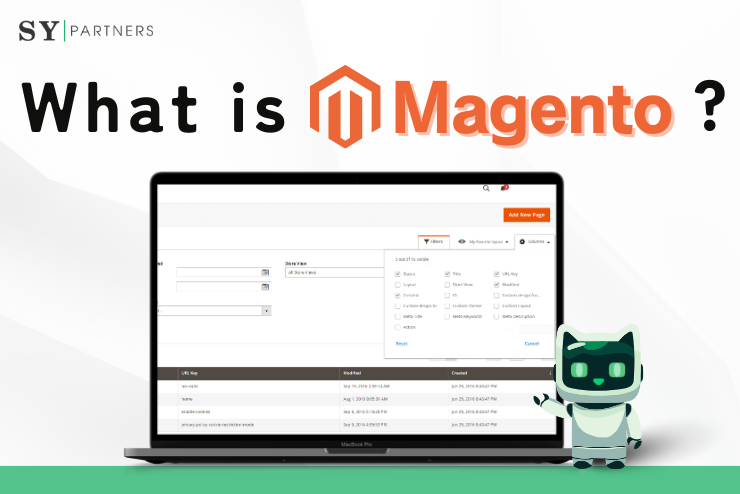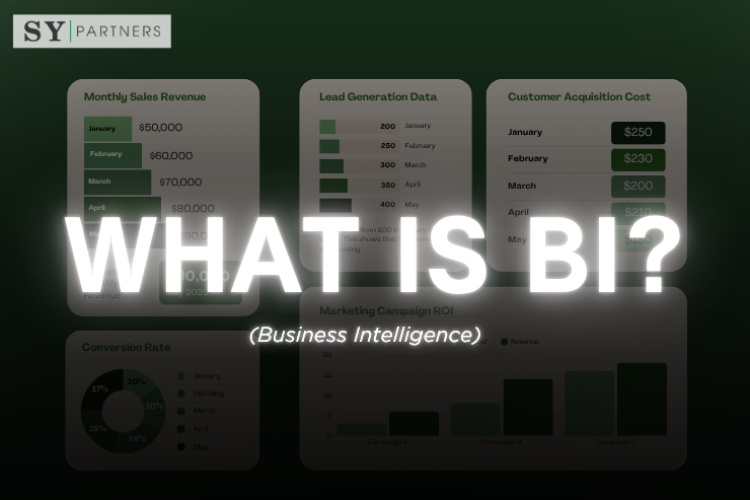What is Magento? Market Share, E-Commerce Features, Comparisons, and Implementation Guide
Magento is a globally adopted e-commerce platform known for its flexibility, extensive customization options, and high scalability. It supports businesses of all sizes—from small startups to large enterprises—enabling them to build and expand online stores that grow in step with their needs.
This article provides a comprehensive overview of Magento’s core functionalities, its differences from other e-commerce platforms, and step-by-step implementation guidance. Additionally, it explores how AI can be integrated into Magento to streamline operations and enhance customer experience. Whether you’re planning a new online store or looking to scale an existing one, this guide will help you evaluate Magento as a strategic solution for efficient e-commerce development.
1. What is Magento?
Magento is an open-source e-commerce platform built on PHP and MySQL. Since its launch in 2008, it has gained wide adoption for its flexibility and scalability. In 2018, Magento was acquired by Adobe and has since been offered as Adobe Commerce, evolving into a comprehensive solution that supports both B2B and B2C business models.
Magento is available in two editions: a free open-source version and a paid enterprise version with enhanced features. Businesses can choose based on their scale and objectives. The platform provides robust tools for product management, payment processing, and customer experience optimization, along with API integrations for seamless connectivity with other systems.
Furthermore, when combined with AI technologies, Magento enables businesses to execute advanced digital strategies, making it a powerful foundation for efficient e-commerce development and long-term growth.
1.1 Purpose of Magento
The primary purpose of Magento is to provide an efficient and scalable e-commerce environment. By centralizing key functions such as product management, inventory management, SEO optimization, and customer segmentation, it enables businesses to increase sales while streamlining operations.
For example, Magento allows multiple online stores to be managed within a single platform, offering high flexibility for global expansion or multi-brand strategies.
Additionally, integrations with ERP and CRM systems consolidate business data, supporting data-driven decision-making. Combined with AI, Magento enables personalization and advanced analytics, delivering optimized experiences tailored to each customer.
1.2 Comparison: Magento Open Source vs. Adobe Commerce
| Feature | Magento Open Source | Adobe Commerce |
|---|---|---|
| Cost | Free (self-hosted) | Paid (license fees apply) |
| Features | Core e-commerce functions | Advanced B2B features, AI-driven personalization, analytics tools |
| Scalability | Suitable for small to medium-sized businesses (extensible) | Optimized for large-scale, high-traffic enterprises |
| Support | Community-based support | 24/7 official enterprise support |
| Integration | Flexible API-based customization | Seamless integration with Adobe ecosystem |
Magento is not just a tool for building online stores—it is a strategic foundation that accelerates business growth. By leveraging the flexibility of open-source development alongside Adobe’s enterprise-grade features, companies can build an e-commerce experience tailored to their industry, scale, and growth objectives.
2. Magento’s Market Share

Magento ranks as the third most widely used e-commerce CMS globally, following WooCommerce and Shopify. Thanks to its flexibility and scalability, it has been adopted by many well-known global brands and high-traffic sites.
Notable adopters include: HP, Nestlé, Hanes, Lenovo, Rosetta Stone, Le Creuset, Paul Smith, MUJI, JTB, Olympus, Canon, KORG, and MonotaRO, among others—spanning industries of all sizes.
These companies operate in environments where high traffic volumes, reliability, and advanced functionality are essential. Magento has earned a strong reputation as a platform capable of meeting these rigorous demands.
3. The Importance of Magento
Magento stands out as a flexible and scalable e-commerce solution, serving businesses of all sizes—from SMEs to global enterprises. It enhances operational efficiency while enabling sustainable growth.
In particular, its customizability and scalability provide a significant competitive edge in today’s fast-moving digital commerce landscape. This section explains Magento’s importance across three key perspectives:
3.1 Strengthening Brands with Flexible Customization
Magento’s open-source architecture allows businesses to freely customize through themes and extensions, enabling unique brand experiences.
- Over 4,000 extensions available on the Adobe Commerce Marketplace
- Easy integration with services for payments, shipping, and inventory management
- Seamless connectivity with ERP/CRM systems (e.g., Exact ERP) for process optimization
This flexibility directly contributes to brand differentiation and strengthens brand value in competitive markets.
3.2 Supporting Growth with Scalability
Magento is built to scale alongside business growth, with architecture that handles surges in traffic seamlessly.
- Supports both horizontal and vertical scaling, maintaining performance during peak periods (e.g., Black Friday)
- Adobe Commerce Cloud leverages cloud infrastructure for dynamic resource allocation
- SMEs can expand their systems step-by-step in line with future growth
This makes Magento suitable for both short-term campaigns and long-term expansion strategies.
3.3 Enhancing Customer Experience
A superior user experience (UX) directly impacts conversion rates and customer loyalty. Magento empowers businesses to deliver better experiences through:
- SEO optimization and mobile responsiveness to improve discoverability and accessibility
- Two-step checkout (Magento 2), which reduces cart abandonment rates by up to 67%
- AI-powered personalization, delivering tailored product recommendations and dynamic pricing
- Integration with Adobe Real-Time CDP, enabling real-time customer data-driven experiences
These features help maximize customer lifetime value (LTV) by providing highly personalized, seamless interactions.
As we’ve seen, Magento is not merely an e-commerce development tool but a core digital foundation that drives growth and strengthens competitive advantage.
In the next section, we will compare Magento with other leading e-commerce platforms to further explore its unique strengths.
4. Comparison of Magento with Shopify, BigCommerce, and Wix
Magento holds a distinctive advantage in terms of customizability and scalability compared to major e-commerce platforms such as Shopify, BigCommerce, and Wix. In this chapter, we will clarify Magento’s positioning and value by comparing it with each of these platforms.

4.1 Magento vs. Shopify
Shopify is a cloud-based e-commerce platform known for its ease of use and fast deployment. It is particularly popular among small businesses and e-commerce beginners, allowing stores to be built quickly through intuitive, user-friendly interfaces.
Magento, on the other hand, is better suited for complex customizations and large-scale businesses. It outperforms Shopify in areas such as multi-store management and advanced B2B functionality. However, Magento typically requires more technical knowledge and a longer initial setup process.
| Feature | Magento | Shopify |
|---|---|---|
| Customization | Highly customizable with extensive APIs | Limited to apps and themes |
| Cost | Free (Open Source) to Paid (Adobe Commerce) | $29–$299/month |
| Scalability | Handles large-scale, high-traffic environments | Best for small to medium businesses, limited scalability |
| Ease of Use | Requires technical expertise | Beginner-friendly, drag-and-drop builder |
Shopify is ideal for businesses seeking quick setup, while Magento excels as a foundation for long-term growth and complex business needs.
4.2 Magento vs. BigCommerce
BigCommerce is another cloud-based platform that offers ease of use while also including enterprise-grade features. It is strong in SEO and app integrations, making it a good choice for businesses looking for a quick and straightforward deployment.
Magento, however, has the upper hand in customization flexibility, advanced B2B features, and global readiness. Its modular PHP architecture allows for building custom functionality without restrictions.
| Feature | Magento | BigCommerce |
|---|---|---|
| Customization | Flexible at the code level | Limited, app- and theme-based |
| B2B Features | Advanced company accounts, custom pricing | Basic B2B support |
| Security | Frequent updates + strong community support | Standard built-in security |
| Globalization | Multi-language and multi-currency supported natively | Limited multilingual support |
While BigCommerce is attractive for its simplicity, Magento is better suited for businesses prioritizing flexibility and international expansion.
4.3 Magento vs. Wix
Wix is primarily a website builder with strong design capabilities, offering e-commerce functions as part of its suite. Its drag-and-drop editor makes it especially appealing for small businesses and creative industries seeking a visually appealing online presence.
However, when it comes to large product catalogs, high-traffic performance, and B2B capabilities, Magento is far more powerful.
| Feature | Magento | Wix |
|---|---|---|
| Design | Custom themes (developer-focused) | Drag-and-drop editor, many templates |
| Scalability | Supports large-scale sites, cloud-ready | Limited scalability, suited for small businesses |
| E-commerce Features | Advanced product management, B2B-ready | Basic e-commerce features only |
| Cost | Free (Open Source) or Paid (Adobe Commerce) | From $23/month |
Wix is excellent for creative design and simplicity, but Magento dominates in depth of e-commerce functionality and long-term scalability.
Magento should not be seen as just another “e-commerce site builder”. Instead, it is a strategic commerce platform that supports growth initiatives. While setup costs and technical requirements may be higher, Magento offers unmatched flexibility, scalability, and long-term competitiveness.
In the next section, we will dive deeper into Magento’s core features to understand what makes it such a powerful platform.
5. Key Features of Magento
Magento comes equipped with a wide range of features essential for running an e-commerce business, ranking among the industry’s best in terms of scalability and flexibility.
Here, we will explore six representative aspects of Magento that support sustainable business growth.
5.1 Product & Inventory Management
Magento offers powerful product registration and inventory management capabilities, making it suitable for businesses with large catalogs and complex SKU structures.
Since Magento 2.4, the platform includes Multi-Source Inventory (MSI) as a standard feature, enabling businesses with multiple warehouses or fulfillment centers to implement flexible stock allocation and shipping logic.
It also supports barcode integration, location-based inventory, and low-stock alerts. When integrated with ERP systems, inventory accuracy and real-time visibility are significantly enhanced.
These advanced management functions drive operational efficiency in both B2B and B2C commerce.
5.2 SEO & Marketing
Magento is well-known for its SEO-friendly architecture and comprehensive marketing tools. Out of the box, it provides features such as custom URL structures, automated meta tag generation, and structured data support, all of which contribute to higher search engine rankings.
On the marketing side, merchants can leverage coupons, promotions, upsell/cross-sell settings, and email marketing integrations with ease.
With Adobe Commerce, businesses gain access to AI-driven product recommendations and personalized offers, creating tailored shopping experiences for each customer. The platform also integrates seamlessly with Google Shopping, social media ads, and omnichannel marketing strategies.
5.3 Mobile Optimization & Checkout
As mobile shopping dominates modern e-commerce, Magento focuses not only on responsive design but also on mobile-first user experience optimization.
Features like two-step checkout, guest checkout, and automatic address completion are specifically designed to reduce cart abandonment.
Using Magento PWA Studio, developers can build Progressive Web Apps (PWAs) that deliver an app-like shopping experience—fast, lightweight, and smooth across smartphones and tablets.
The platform also supports diverse payment gateways, including Apple Pay, Google Pay, Stripe, and more.
5.4 APIs & System Integration
Magento adopts an API-first architecture, supporting REST and GraphQL APIs to connect with a wide range of external systems.
Examples include integrations with ERP systems (SAP, Oracle, Exact), CRM tools (Salesforce, HubSpot), and other enterprise applications, enabling centralized management of inventory, customer data, and sales records.
The extensible ecosystem also makes it easy to integrate with accounting software, POS systems, and marketing automation platforms.
With enhanced GraphQL support, developers can decouple front-end and back-end development, improving agility and enabling highly customized UI/UX experiences.
5.5 Security & Performance Enhancements
With the release of Magento 2.4.8 (2025), security has been significantly strengthened, including more than 497 bug fixes. Key protections were improved against XSS, CSRF, and XML injection attacks, ensuring the robust reliability required for e-commerce operations.
Admin security has also been bolstered with two-factor authentication (2FA), CAPTCHA support, and stricter password policies.
Performance-wise, Magento integrates with Varnish and Redis to accelerate caching and maintain stability during peak traffic events such as flash sales.
Support for CDN and cloud infrastructure makes it possible to optimize global content delivery and ensure high availability.
5.6 Headless Commerce & Next-Generation Architecture
Magento is rapidly advancing toward headless commerce, allowing businesses to decouple the front-end and back-end for maximum flexibility in development.
This enables the use of modern JavaScript frameworks like React.js and Vue.js to deliver richer user experiences.
With PWA Studio at its core, Magento supports faster mobile performance, offline browsing, and push notifications, delivering an app-level experience directly via the web.
Looking ahead, Magento is positioned to integrate with IoT devices, digital signage, and other emerging channels, further strengthening its multichannel commerce capabilities.
Magento’s robust features unlock new business possibilities and empower long-term growth. In the next section, we will explore how to implement Magento effectively.
6. Steps to Implement Magento
Successfully implementing Magento requires a structured, phased approach—from preparation and setup to launch and ongoing operations. Below, we outline the essential steps you need to follow for a smooth deployment.
6.1 Requirements Definition
The first step is to clearly define the requirements of your e-commerce site. This includes:
- Number of products and SKUs to be managed
- Expected traffic volume and scalability needs
- Required features (e.g., multilingual support, B2B functions, third-party integrations)
- Security and compliance requirements
- Internal operational structure and team responsibilities
By carefully outlining these requirements upfront, you can avoid unnecessary adjustments later, prevent gaps or redundancies in functionality, and establish the right architectural direction from the start.
6.2 Selecting the Magento Edition
Based on the requirements, determine which edition of Magento best fits your business:
- Magento Open Source: Free to use, offering core e-commerce functionality. Best suited for small to medium-sized businesses.
- Adobe Commerce (formerly Magento Commerce): Paid enterprise-grade solution that includes advanced features such as B2B commerce, personalization, AI-driven recommendations, dedicated support, and enterprise integrations.
Choosing the right edition with scalability in mind is essential for long-term growth.
6.3 Server & Infrastructure Setup
Magento requires a robust hosting environment to operate efficiently. Key infrastructure components include:
- Web server: Apache or Nginx
- PHP: Version 8.x or higher (depending on Magento release)
- Database: MySQL or MariaDB
- Caching layer: Redis and Varnish to accelerate performance
If hosting on your own infrastructure, you’ll need to build and maintain the environment. Alternatively, leveraging AWS, Adobe Commerce Cloud, or other managed hosting providers can reduce operational overhead while ensuring scalability and uptime.
6.4 Theme, Design & Customization
The visual design of your Magento store directly impacts your brand identity and user experience. Magento provides default themes such as Luma and Blank, but for businesses with unique design requirements, you may need to customize an existing theme or develop a fully bespoke theme.
Key considerations include:
- Responsive design for seamless multi-device usability
- Accessibility compliance for inclusive UX
- User-friendly navigation and checkout flow
- Mobile optimization, potentially via Magento PWA Studio, to deliver app-like performance
6.5 Installing Extensions
One of Magento’s greatest strengths is its extensibility. The Magento Marketplace offers over 4,000 extensions covering areas such as:
- Payment processing
- Shipping & logistics
- Inventory management
- SEO optimization
- Marketing automation
- Localization & multi-store management
By selecting trusted, high-quality extensions, you can enhance functionality while minimizing custom development. Always test the performance and compatibility of extensions after installation.
6.6 Testing & Quality Assurance
Before going live, conduct thorough testing in a staging environment to ensure system reliability. Key areas include:
- Order workflows: Product selection, checkout, payment, and order confirmation
- Inventory synchronization with warehouses or ERP
- Email notifications and customer communication
- Page speed and SEO compliance
- Security testing: including vulnerability scans and penetration testing
- User acceptance testing (UAT) from both business and customer perspectives
Automated test scripts and manual validation together help reduce risks and ensure a stable launch.
6.7 Production Launch & Go-Live
Once all tests are passed, proceed with deployment to the production environment. Final preparations should include:
- DNS configuration and domain setup
- SSL certificate installation
- Log monitoring and error tracking systems
- Backup and recovery planning
Immediately after launch, closely monitor system performance, transactions, and customer feedback. Strengthen support and response protocols during the initial launch phase to handle unexpected issues quickly.
Ensuring a Successful Deployment
Magento’s powerful features and high scalability require a certain level of technical expertise to implement and manage. If your in-house team lacks the necessary resources, it is highly recommended to partner with an experienced Magento development agency or certified solution provider.
By leveraging professional support across requirements definition, implementation, and ongoing operations, you can minimize risks, accelerate deployment, and achieve stable performance from day one.
Magento Consulting & Development with SY Partners
At SY Partners, our Magento e-commerce consulting and development services cover the entire lifecycle—from strategic planning and system design to implementation, optimization, and continuous growth.
With extensive Magento expertise and proven experience, we deliver tailored e-commerce solutions aligned with your business objectives. We ensure seamless migration, stable operations, and measurable results, while offering multiple approaches to meet your unique goals and challenges.
Conclusion
Magento is a highly customizable and scalable e-commerce platform. Magento Open Source provides a cost-effective solution for small and mid-sized businesses, while Adobe Commerce is best suited for large enterprises and B2B commerce.
With its rich feature set and flexibility, Magento outperforms competitors like Shopify and BigCommerce in handling complex requirements.
Key strengths include advanced inventory management, personalized customer experiences, and AI-driven recommendations—all contributing to revenue growth.
To ensure a successful implementation, it is critical to choose the right edition, customize design and functionality, integrate necessary extensions, and conduct comprehensive testing. With the right planning and support, Magento can become the foundation of long-term e-commerce success.


 EN
EN JP
JP KR
KR




